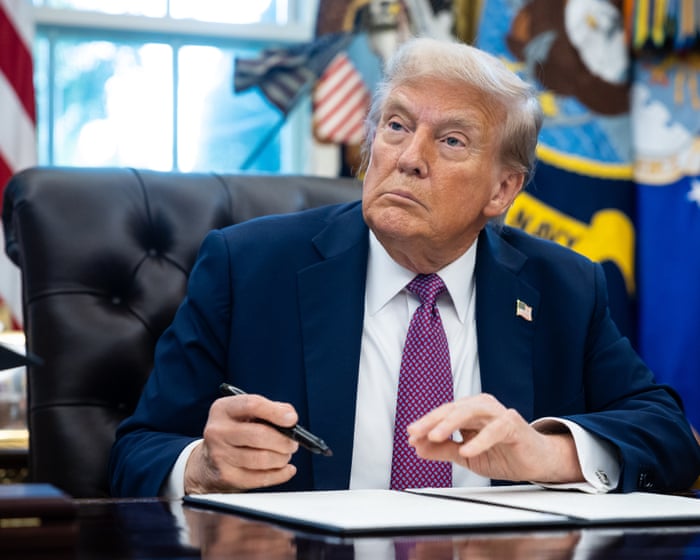Last week, Donald Trump casually remarked that if the Supreme Court overturns his tariff policies, he might have to undo some of the trade deals made since he declared “liberation day” in April. This was yet another reminder—as if one were needed—that nothing in Trump’s economic agenda is fixed. Not only does the aging president change his demands on a whim, but it’s also unclear how much power he actually has to enforce them.
Even if the “reciprocal” tariffs announced on April 2 are reversed, they are just one part of a broader attack on what remains of the “Washington consensus.”
To name a few recent actions, Trump has taken a 10% government stake in Intel, demanded 15% of Nvidia’s revenue from chip sales to China, and suggested the CEO of Goldman Sachs should step down. At the same time, he has undermined Federal Reserve independence by insulting its chair, Jerome Powell, and attempting to remove Lisa Cook from the board.
The head of the Bureau of Labor Statistics was fired after a series of weak jobs reports, and Jennifer Abruzzo, chief of the National Labor Relations Board, was also dismissed. Tech supporters of Trump dislike the NLRB for its role in protecting workers’ rights, such as requiring unionization votes at Amazon warehouses.
Trump’s approach is both systematic in its goal to dismantle existing norms and utterly chaotic. It defies easy categorization: corporate America is being unleashed through the erosion of environmental and labor standards, while also being reined in.
For example, Senator Bernie Sanders praised Trump’s move to take a stake in Intel in exchange for government grants—an idea Sanders himself advocated in the Guardian in 2022. Meanwhile, some Republicans have criticized the approach as, heaven forbid, “socialism.”
So far, the market’s reaction to this upheaval has been muted, partly because it coincides with an AI-driven stock boom that has sent tech company valuations soaring.
After another three and a half years of this turmoil, the U.S. economic model is likely to be unrecognizable from what it has been in recent decades.
This transformation didn’t happen overnight. The era when the U.S., as the world’s undisputed economic superpower, could export free-market capitalism worldwide has long passed. After the 2008 financial crisis—fueled by Wall Street—the U.S. lost any moral or practical authority to serve as an economic example for other nations.
As the crisis spread globally and the U.S. government bailed out large parts of the financial sector, the myth of laissez-faire economics was exposed. The risks of hyper-charged capitalism became clear not just in the U.S., but also in countries like those in the former Soviet bloc that had been urged to adopt the model wholesale.
As Ivan Krastev and Stephen Holmes argued in their book The Light that Failed, “Confidence that the political economy of the West was a model for the future of mankind had been linked to the belief that Western elites knew what they were doing. Suddenly it was obvious that they didn’t.”Back in the US, as in the UK, the belief that banks were rescued while those responsible for the crisis escaped punishment fueled a deep sense of injustice. Even before the financial crash, the promise that expanding free trade would bring broad economic gains was undercut by the reality that it led to deindustrialization and job losses in America’s Rust Belt and the UK’s former industrial regions.
This environment made Trump’s populist economic message resonate. In hindsight, his first-term tariffs on China were a relatively restrained attempt, in his view, to rebalance trade in America’s favor. President Biden did not reverse these tariffs, as geopolitical tensions with China grew and hopes that economic liberalization would encourage democratic reforms faded under Xi Jinping’s increasingly authoritarian rule.
Biden also adopted an assertive approach to economic policy, using the Inflation Reduction Act to direct billions in subsidies and loans toward cutting carbon emissions and creating jobs. The notion that US free-market capitalism was unchallenged before Trump is misleading, but the speed at which he is dismantling its remaining norms is remarkable.
There is room for legitimate debate here. For instance, state involvement in strategic industries is more common in Europe. Trump may be setting precedents that future US administrations with different goals could follow.
Given the lack of clarity about what kind of economy Trump is aiming for, the prevailing feeling is one of profound uncertainty. Recent weak jobs data, with unemployment nearing a four-year high, suggests businesses are growing cautious.
For now, investors seem to be looking the other way, encouraged by expectations of Federal Reserve rate cuts and strong tech sector returns. Yet with each chaotic week, risks are mounting. As the UK learned after Liz Truss’s brief tenure, economic credibility is easily lost and hard to regain.
Frequently Asked Questions
Of course Here is a list of FAQs about Donald Trumps economic impact written in a clear and natural tone with direct answers
General Beginner Questions
Q What is meant by Trumps whirlwind impact on the US economy
A It refers to the rapid and significant changes he implemented through policies like tax cuts tariffs and deregulation which sharply shifted the countrys economic direction away from previous administrations
Q What were the main goals of Trumps economic policies
A The primary goals were to boost economic growth through tax cuts bring back manufacturing jobs reduce the US trade deficit and lessen the regulatory burden on businesses
Q Did Trumps policies help the average American
A Its debated Supporters point to low unemployment and stock market gains before the pandemic which benefited many Critics argue the benefits were uneven with wealth gains concentrated at the top and tariffs raising costs for consumers
Q What is a tariff and why did Trump use them so much
A A tariff is a tax on imported goods Trump used them as a tool to try to protect US industries from foreign competition and pressure other countries especially China to change their trade practices
Advanced Detailed Questions
Q How did the 2017 Tax Cuts and Jobs Act reshape the economic model
A It significantly lowered corporate tax rates with the aim of encouraging business investment in the US It also lowered individual income taxes for most though the benefits were more pronounced for higher earners and corporations
Q What is the argument that his policies were more shortterm boost than longterm reshape
A Critics argue that the tax cuts fueled a sugar rush of growth and stock buybacks but added massively to the national debt without making foundational investments for sustainable longterm prosperity
Q How did the trade war with China impact the US economic model
A It moved the US toward a more protectionist stance using tariffs as a primary tool This disrupted global supply chains hurt US farmers and manufacturers who relied on Chinese imports and led to higher prices for consumers on many goods
Q What is deregulation and what was its economic effect




